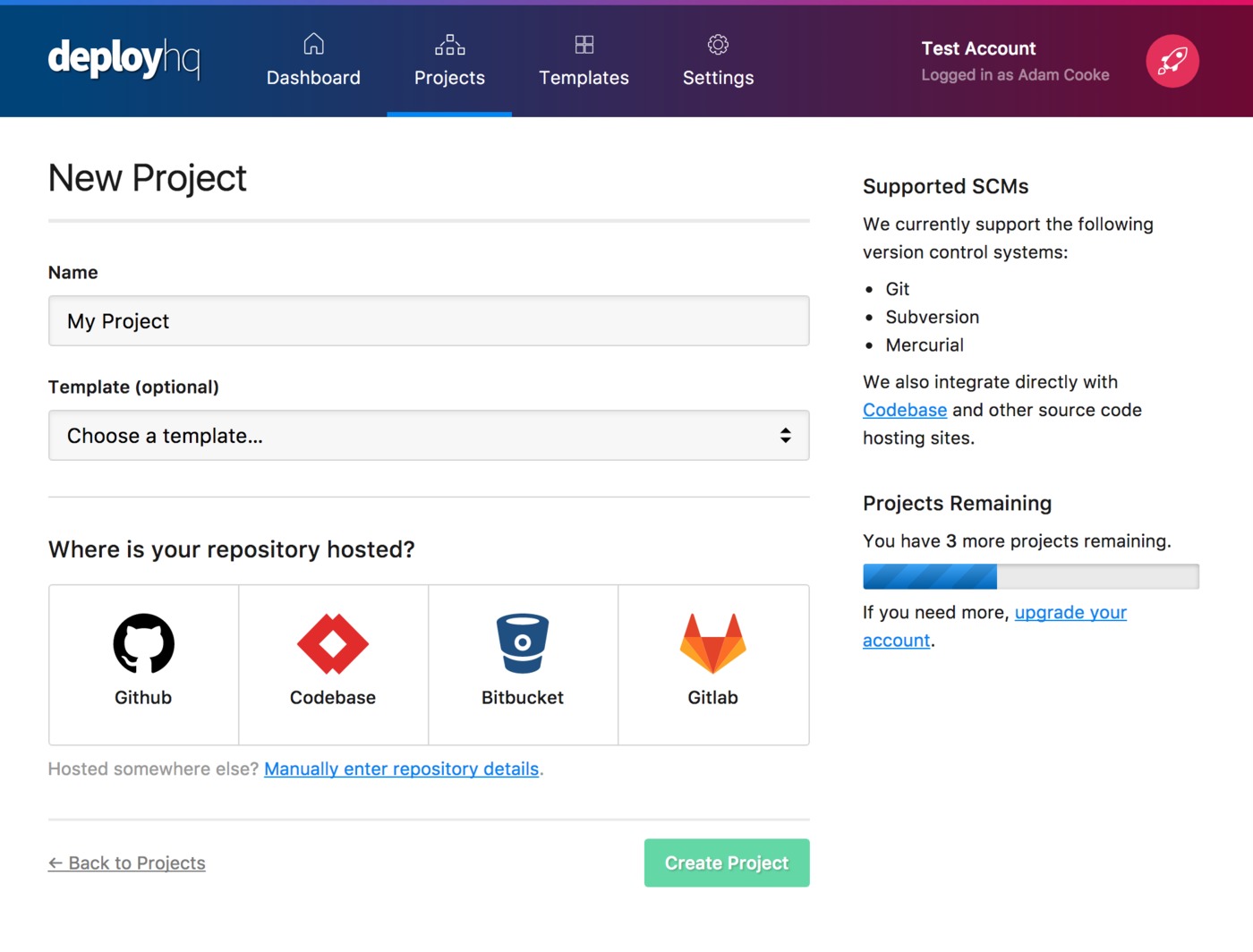Deploying to Netcup via DeployHQ: Automated Server Deployment
Deploying to your Wordpress site hosted with netcup is very simple with DeployHQ. Firstly, you'll need to set up your DeployHQ project, then connect to your netcup server.
Setting up your project
Head to the Projects screen in DeployHQ, then click the New Project button to get started. You'll be prompted to enter a name for your project, then select where your repository is hosted.  Next, click Create project and you'll be taken to a screen where you can log in with your repository hosting account to authorise access and then choose your repository.
Next, click Create project and you'll be taken to a screen where you can log in with your repository hosting account to authorise access and then choose your repository.
- Adding a Bitbucket repository
- Adding a Codebase repository
- Adding a GitHub repository
- Adding a GitLab repository
- Adding a repository manually
Setting up your netcup server
Once you've configured your repository, you'll need to connect to your netcup server. Head to Servers & Groups, and click the New Server button at the top of the screen. If you've just added your repository, you will have been taken to this page automatically.
Start by entering a name, and choosing SSH/SFTP as the protocol: 
Next, enter your netcup server's hostname, your username and port (typically 22) and password. To find your SSH credentials:
- Log into your netcup customer control panel (CCP)
- Navigate to "Web Hosting" section
- Select your specific hosting package
- Go to "SSH Access" settings
- Generate or view SSH credentials
Important netcup SSH Access Notes:
- SSH access is available on most hosting plans
- Steps to enable SSH:
- Log into netcup customer control panel
- Go to Web Hosting management
- Activate SSH access
- Set up SSH key or password
- Two-factor authentication recommended
Typical netcup Hostname Formats:
- Shared Hosting:
ssh.yourdomain.de - Personal Domain:
ssh.yourdomain.com
Here, if you wish, you can also use an SSH key instead of a password, which is set up by taking the SSH key in your DeployHQ server configuration page, and pasting it in your netcup server, in ~/.ssh/authorized_keys. 
Connection Troubleshooting:
- Verify SSH is activated in your hosting plan
- Confirm correct hostname
- Ensure you're using the correct username
- Check IP whitelist settings
- Validate credentials in netcup control panel
Once this is done, you can enter a deployment path (where you want files to be placed on the server).
Typical netcup Wordpress Path:
- Shared Hosting:
/home/username/www/ - WordPress Specific:
/home/username/www/wordpress/ - Web Root:
/home/username/www/htdocs/
Next, within Deployment options, you can choose to automatically deploy your server and, if you're only deploying files from a certain directory in your repository, enter a Deployment subdirectory. 
In this case, as you probably just want to deploy your Wordpress theme folder, you'll enter the path to the theme. If you only keep the theme in version control, you can leave it blank.
Click Create Server to finish, then you can proceed to start your first deployment.
Run your first deployment
By default, DeployHQ will upload the whole repository to your server on the first deployment, because there is no previously deployed commit to compare to.
If your files are already on netcup though and up to date with the latest commit, you can follow this guide to skip that first deployment:
Otherwise, just follow this guide to start your first deployment, then after the first deployment, only files that have changed will be uploaded in future.
That's it! You've now set up and run your first deployment to your netcup server and your future changes will be uploaded for you automatically, or at the simple click of a button.
Further reading
DeployHQ has a number of very useful features to help with your Wordpress deployments in general that you might wish to find out more about:
- Compiling assets and javascript with the Build pipeline
- Running commands on your server with SSH commands
- Stop certain files from being uploaded in deployments using Excluded files
- Keep important files safely away from your repository using Config files
- Keep your team in the loop and run other useful tasks during a deployment with our Integrations
_Want to learn more about deployment or Wordpress? Check out our documentation or contact our support team for assistance.